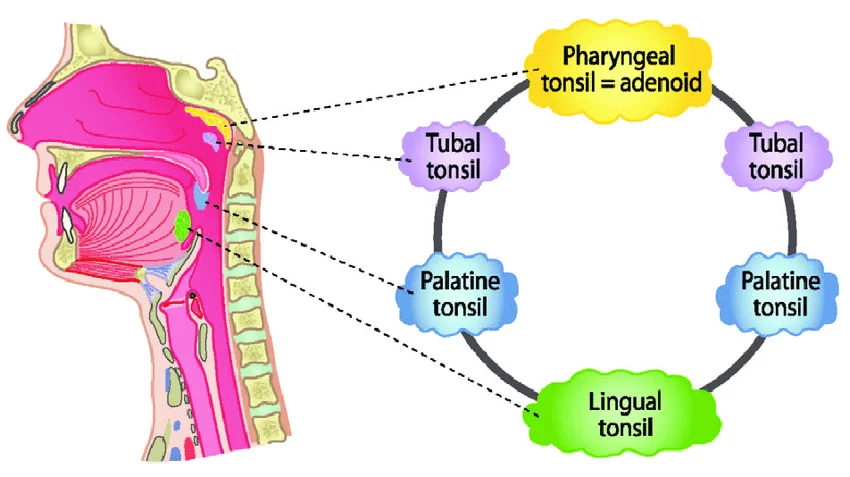
Waldeyer’s ring is a ring of lymphoid tissue surrounding the nasopharynx and oropharynx. These are sites of first immunological contact for antigens in childhood. These are also called nasal-associated lymphoid tissue (NALT) or mucosa-associated lymphoid tissue (MALT).
Waldeyer’s ring named after Heinrich Wilhelm Gottfried Waldeyer (1836-1921), a renowned German anatomist, physiologist, and pathologist.
Waldeyer’s ring has two components, namely the inner and outer rings. The inner ring is constituted by,
- adenoid (nasopharyngeal vegetations) at the roof of nasopharynx,
- tubal tonsils (or tonsil of Gerlac) which surrounds the pharyngeal ends of eustachian tube,
- palatine tonsils (or faucial tonsils) on either side of oropharynx,
- lingual tonsil in the posterior one third of the tongue and
- sub epithelial lymphoid tissue found in the posterior pharyngeal wall.

In its accurate interpretation, the outer ring comprises transcervical lymph nodes situated between the head and neck. These nodes are organized in a circular fashion at the boundary of the head and neck regions and encompass:
- Sublingual lymph nodes,
- Submental lymph nodes,
- Submandibular lymph nodes,
- Parotid lymph nodes,
- Retroauricular lymph nodes,
- Occipital lymph nodes, and
- Retropharyngeal nodes.
Functions of Waldeyer’s rings
Waldeyer’s ring constitute an antigen sampling center in the entry sites of upper respiratory tract, where the antigens are caught and sampled stimulating the immune mechanism. Antigens from inspired air are trapped by the adenoid and the tubal tonsils, while antigens from ingested foods are taken care of by the palatine and lingual tonsils. These antigens in turn stimulate release of immunoglobins by the B lymphocytes.
To facilitate exposure and trapping of antigens the mucosa covering the adenoid is thrown into grooves called as furrows. These furrows serve to increase the surface area of the adenoid tissue. Similarly, antigens from ingested food are captured and sampled by the lingual and palatine tonsils. The mucosa covering the palatine tonsils are thrown into numerous crypts about 6 – 20 in each tonsil. These crypts serve to increase the surface area of mucosa covering the tonsil.
Pathologies of Waldeyer’s ring
All the structures of Waldeyer’s ring have similar histology and function, and they produce similar symptoms and require treatment.
- Inflammatory and infectious diseases like tonsillitis, adenoiditis etc.
- In response to recurrent infections, adenoids and tonsils can hypertrophy and lead to airway obstruction. One of the major complications is snoring and obstructive sleep apnea.
- Enlarged adenoids can cause eustachian tube dysfunction and otitis media with effusion.
- These lymphoid tissues in inner ring reaches its maximum size by 10 years of age and then gradually regresses. In patient’s where it fails to regress, it can cause symptoms.
- Waldeyer’s ring lymphoma accounts for approximately 50% of all extra nodal non-Hodgkin’s malignant lymphomas in the head and neck. The most common sites of occurrence (in order of frequency) are the tonsils, nasopharynx, and base of the tongue. Patients usually present with airway obstruction, otalgia, decreased hearing, pain, or sore throat.
- Waldeyer’s ring is considered for staging of malignant lymphomas according to the Ann Arbor classification.
- Amyloidosis of the tonsil is a rare condition and amyloidosis of Waldeyer’s ring has been reported, though very rare.